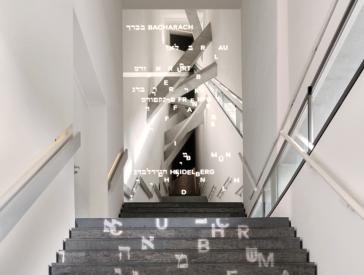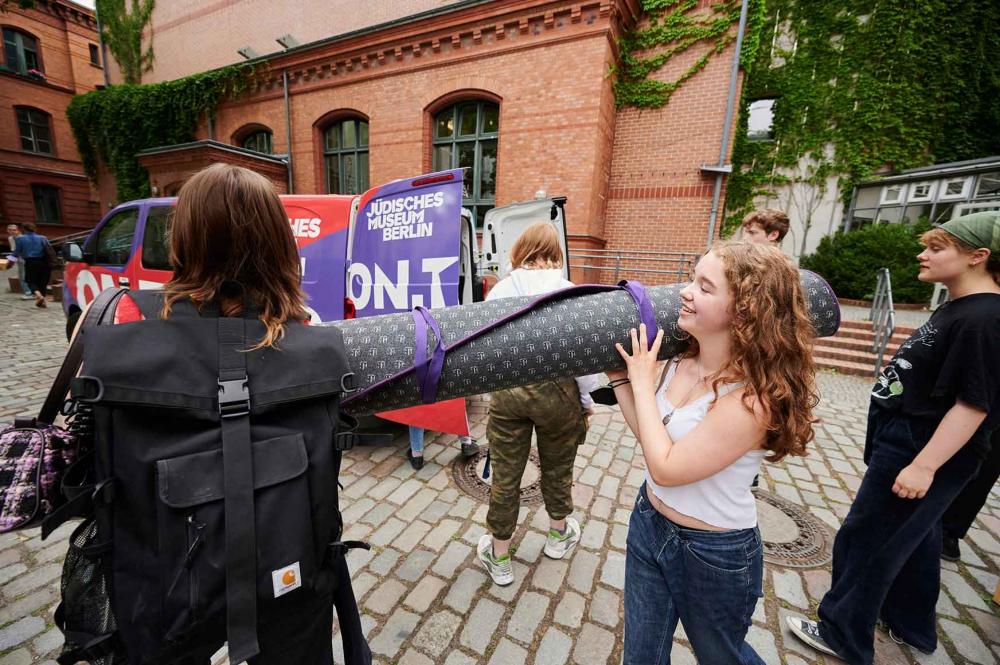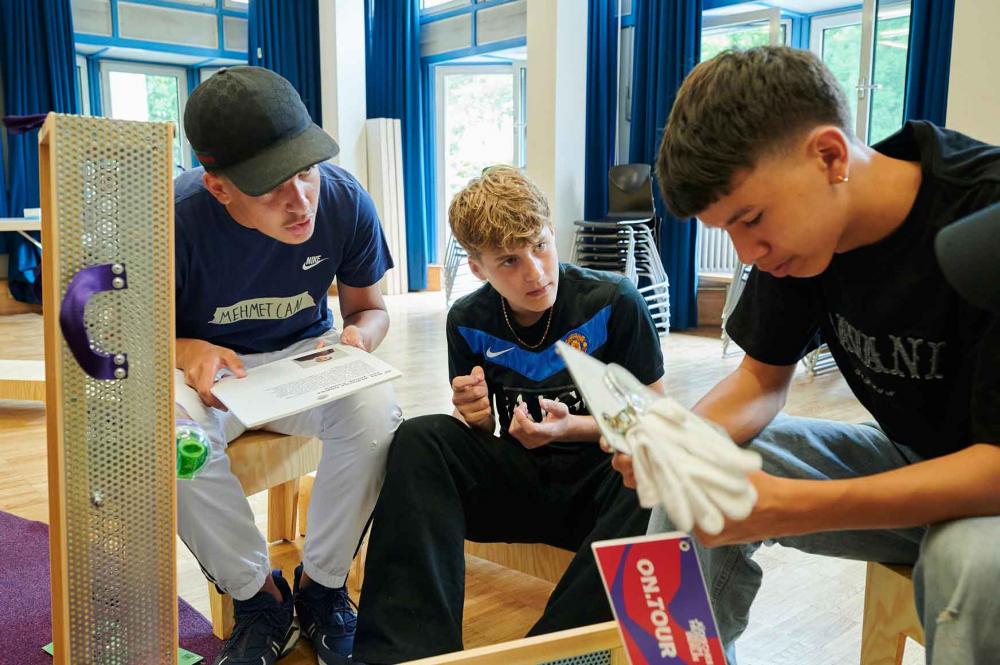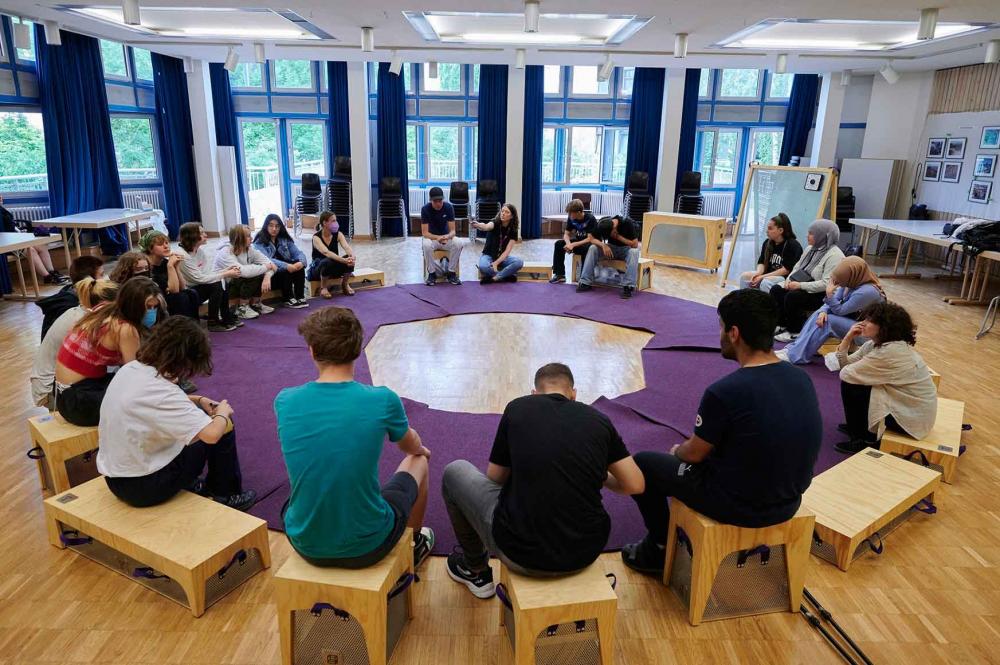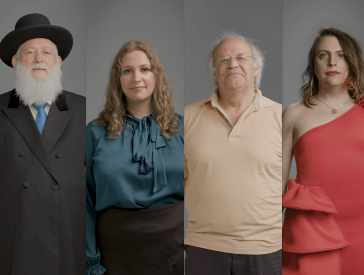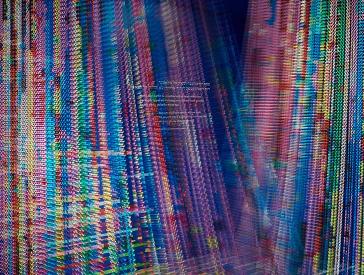
JMB on.tour
The Jewish Museum Berlin is Coming to You!
For more than 15 years, the Jewish Museum Berlin has been visiting students throughout Germany with JMB on.tour.
Our program transmits age-appropriate knowledge about German-Jewish culture, history and the present day to youths 12 years and over and young adults. The offer consists of four interactive workshops for four school classes per day and provides space for an open exchange led by museum facilitators.
It has already reached more than 75,000 youths in over 600 schools across all German states. Our tour is continuing – join us by applying now!
Trailer to the mobile exhibition JMB on.tour; Jewish Museum Berlin 2023
An overview of JMB on.tour
- Four workshops (WS) (two based on the mobile exhibition and two in the classroom) for four school classes, lasting three lesson periods each
- Mobile exhibition that comes to schools in the on.tour bus
- Target group: Youths 12 years and over and young adults
- Free and inclusive
Procedure
| 15 min before school starts | Arrival at the school, unloading the tour bus | |
|---|---|---|
| 1st-3rd lesson | 1st WS with the exhibition with class A | 1st WS in the classroom on the topic of anti-Semitism OR diversity with class B |
| 4th-6th period | 2nd WS with the exhibition with class C | 2nd WS in the classroom on the topic of anti-Semitism OR diversity with class D |
| after the 6th lesson | Packing the tour bus, departure |
An on.tour day in pictures

The on.tour bus is bringing the exhibition to teenagers and young adults; Jewish Museum Berlin, photo: Yves Sucksdorff.

Participants approach the topics in a playful way using a parachute; Jewish Museum Berlin, photo: Yves Sucksdorff.
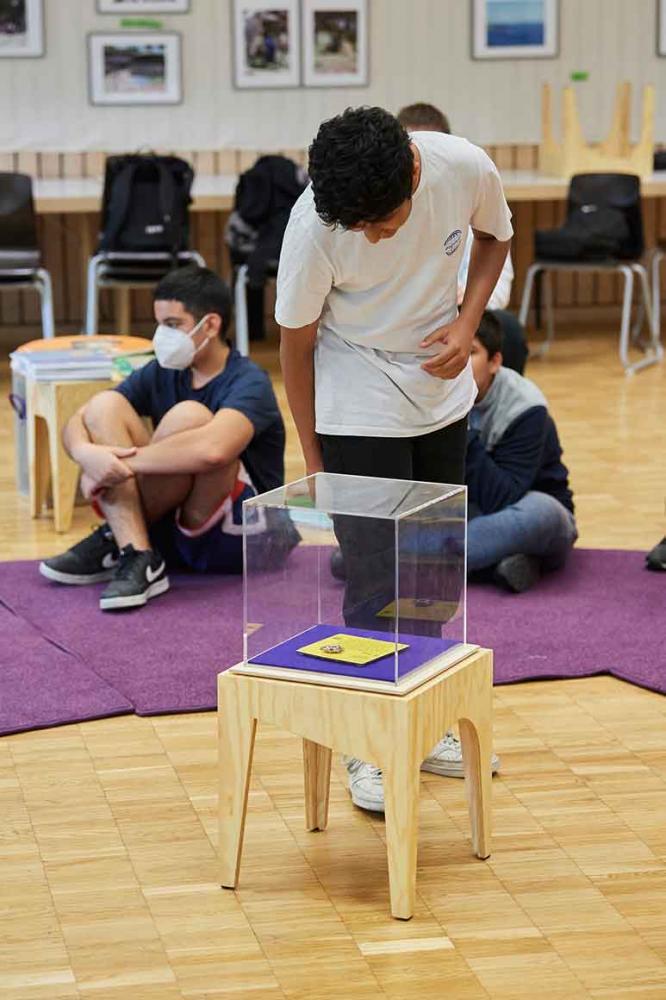
What is a Jewish object? What does the Jewish Museum Berlin collect? And why?; Jewish Museum Berlin, photo: Yves Sucksdorff.
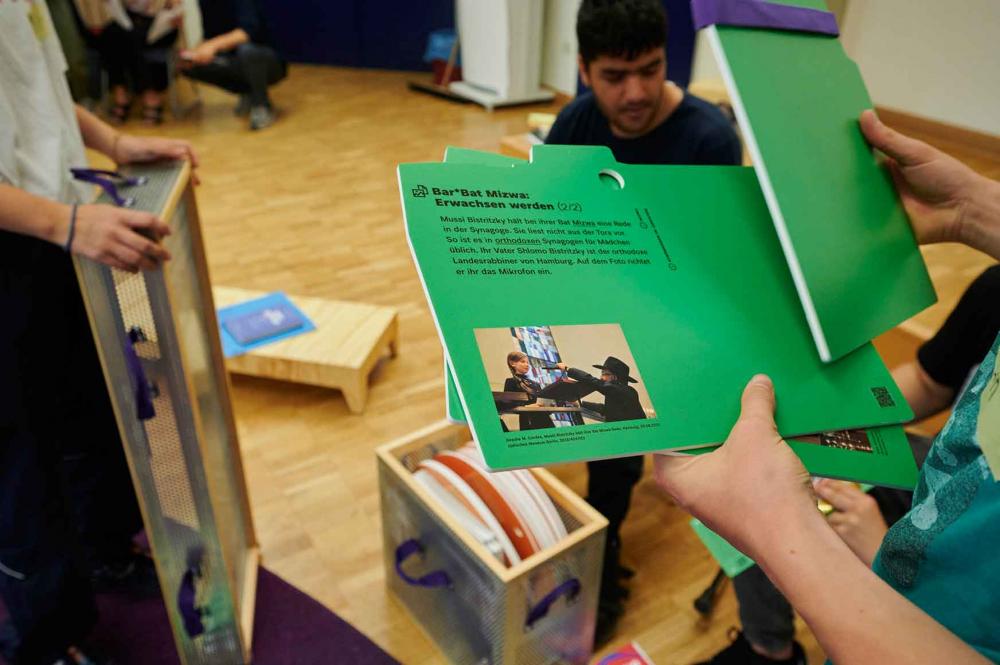
JMB on.tour uses various materials, such as multi-sensory hands-on objects, biographies, documents and photographs, as well as videos, audio material and displays with explanatory texts; Jewish Museum Berlin, photo: Yves Sucksdorff.

What do kosher gummy bears taste like? Young people can taste this exhibit for themselves; Jewish Museum Berlin, photo: Yves Sucksdorff.
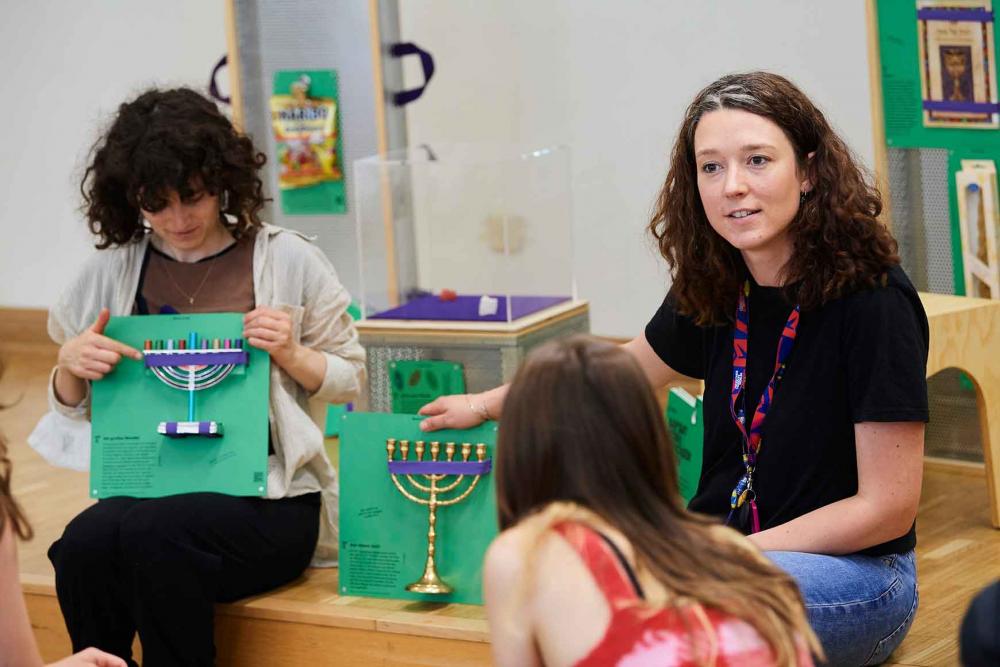
The facilitators supervise the participants and answer questions about Judaism and being Jewish in the past and present; Jewish Museum Berlin, photo: Yves Sucksdorff.
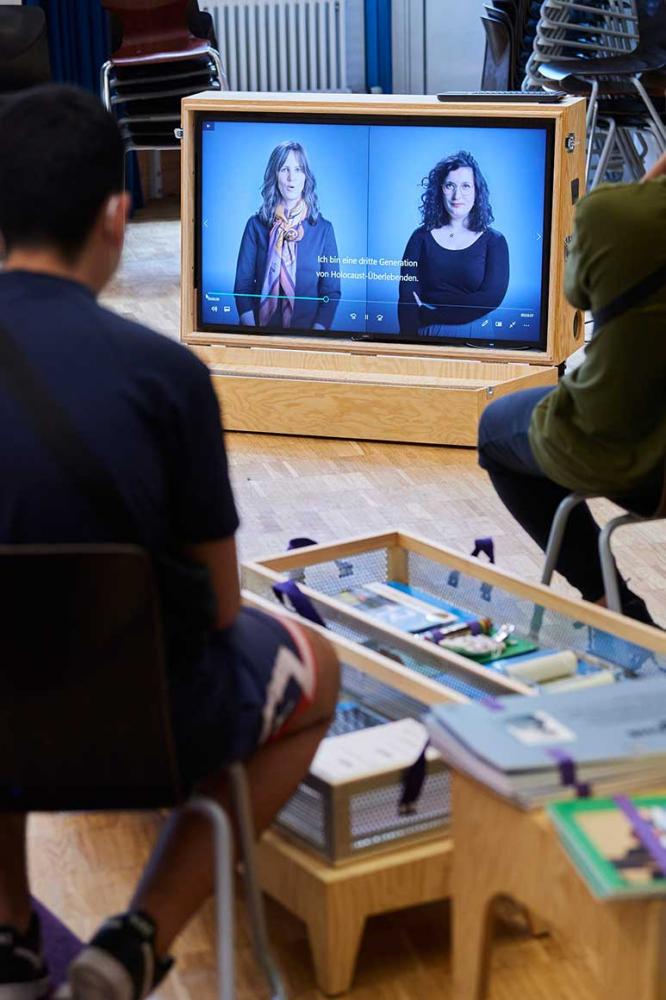
With several tablets and a large monitor, JMB on.tour also shows digital exhibits, like one of the Four Questions films by Yael Reuveny; Jewish Museum Berlin, photo: Yves Sucksdorff.
JMB on.tour-dates 2025
State |
Tour dates |
Please apply until |
|---|---|---|
| Bremen and Lower Saxony | 3 to 7 Mar 2025 | 17 Jan 2025 |
| Berlin | 2 to 4 Apr 2025 | |
| Saxony-Anhalt | 2 to 6 Jun 2025 | 7 Mar 2025 |
| Brandenburg | 23 to 27 Jun 2025 | 2 May 2025 |
| Mecklenburg-Western Pomerania | 7 to 11 Jul 2025 | 9 May 2025 |
| Saxony | 15 to 19 Sep 2025 | 28 May 2025 |
| Berlin | 13 to 17 Oct 2025 | |
| Thüringen | 17 to 21 Nov 2025 | 29 Aug 2025 |
on.tour workshops
All workshops last three lesson periods, are designed for one school class each and are run by museum facilitators. The workshop in the mobile exhibition takes places twice in succession. Two classroom workshops are run in parallel. You can choose between the topics “Jewish Diversity in Present-day Germany” and “Antisemitism.”
What is the JMB on.tour workshop in the mobile exhibition about?
Grade level: 6 to 13
Number of participants: max. 30 students
Length: 3 lesson periods
Location: a large room e.g. an auditorium or a gymnasium (at least 8 x 8 meters)
How many times: twice in one on.tour day
The mobile exhibition conveys knowledge about Jewish religion and culture and German-Jewish history as well as the present. Topics can include the Torah and Talmud, dietary laws (Kashrut), the Sabbath (day of rest), Jewish places, the significance of migration stories for present-day Jewish life in Germany and Jewish perspectives on the Holocaust and forms of remembrance.
The workshop revolves around independent, interest-led discovery with the aid of around 40 hands-on exhibits: What does a broken glass, a pack of Fromms condoms or a soccer shirt have to do with Judaism? Discussions with the on.tour facilitators connect questions to young people’s own lives: How do you watch what you eat? Is there anything you don’t eat on principle? What do you want to free yourself from? What languages do you switch between? The museum itself is also part of the discussion: What actually is a Jewish object? What does the Jewish Museum Berlin collect? And what would you donate to a museum or let it exhibit?
The facilitators respond to the individual needs and interests of each group and adapt the contents to the group’s prior knowledge and curriculum. This workshop takes place twice in succession.
What is the JMB on.tour workshop “Jewish Diversity in Present-day Germany” about?
Grade level: 8 to 13
Number of participants: max. 30 students
Length: 3 lesson periods
Location: Classroom
How many times: max. twice in one on.tour day
Who is a Jew? What is Jewish? And what defines me? The workshops is centered on artist Yael Reuveny’s film Four Questions, in which she asks Jews about their Jewish identity. The protagonists present Jewish life today in a multifaceted, contradictory and entertaining way. Participants discuss their own approach to life and share their opinions on the wide-ranging statements in the film. In doing so, they recognize the diversity of Judaism in Germany and can reflect on their own stereotypes.
What is the JMB on.tour workshop “Antisemitism – Myths about Jews” about?
Grade level: 9 to 13
Number of participants: max. 30 students
Length: 3 lesson periods
Location: Classroom
How many times: max. twice in one on.tour day
Contempt for Jewish tradition and the rejection of Jews have repeatedly led to hate and violence throughout history. Today, Jewish institutions in Germany are under police protection. In this workshop, we address the complex phenomenon of antisemitism by using film case studies that participants respond to. They discuss the antisemitic nature of the incidents and exchange arguments. The participants’ ideas and experiences will be included in the open discussion. The aim is to exchange perspectives and form one’s own opinion, thereby creating an understanding of what antisemitism is and how it can present itself.
How inclusive is JMB on.tour?
In JMB on.tour, participants explore more than forty exhibits that they can touch, look at, listen to and even taste and smell. There is also a diverse array of biographies, photos, documents, quotes and in-depth explanatory texts. All parts of the exhibition have at least the title printed in Braille, and panels with quotes from Jews, for example on dietary laws, are fully legible in Braille. All texts are written in plain language and have been designed with tactile QR codes that can be used with screen readers. Our trained facilitators tailor the exhibition to participants with disabilities or limitations in the areas of hearing, seeing, moving and understanding.
How was JMB on.tour developed?
Various advisory boards were involved in developing JMB on.tour.
Students from two Berlin schools served on the school advisory board where they tested the prototypes and provided important feedback. The Biesalski School in Dahlem has a special pedagogical focus on “physical and motor development” and “autism.” The Refik Veseli School is an integrated secondary school in Kreuzberg.
Experts from the General Association for the Blind and Visually Impaired in Berlin and the Institute for Rehabilitation Sciences at Humboldt University supported JMB on.tour with their knowledge on the Inclusion Advisory Board.
Editorial staff at the magazine Ohrenkuss checked the texts for readability and, together with the expert Anne Leichtfuss, translated the texts into plain language.
With Funding Provided by


